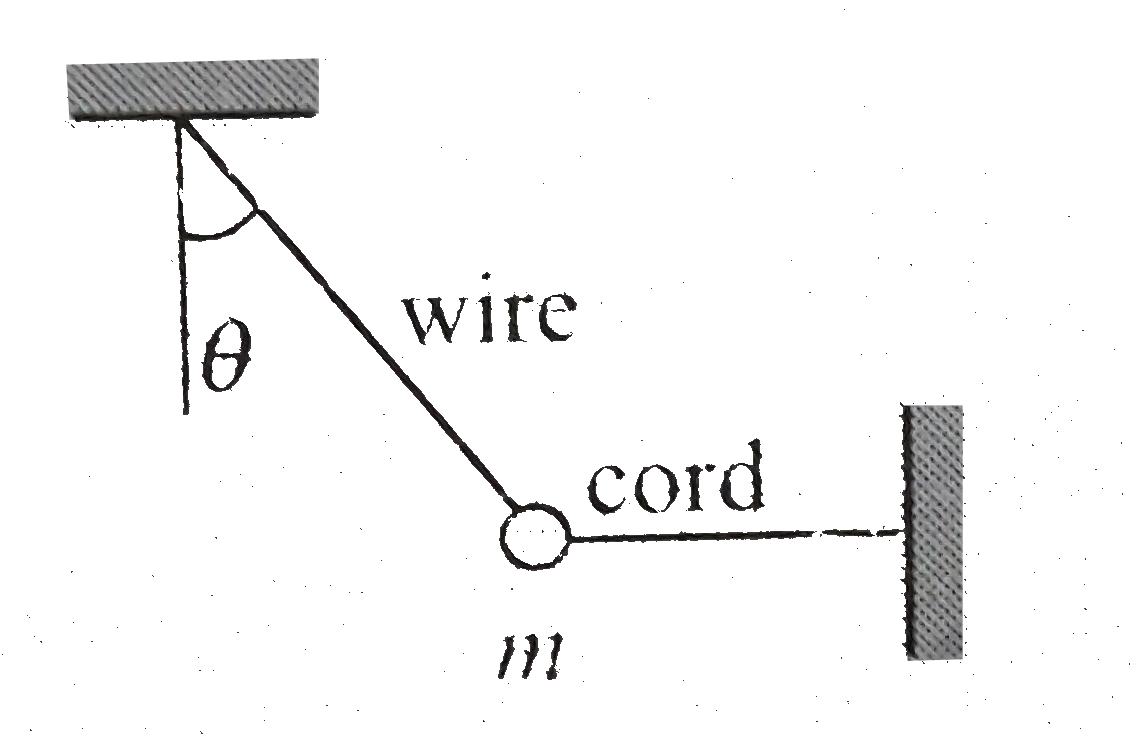A simple pendulum swings with angular amplitude θ. The tension in the string when it is vertical is twice the tension in its extreme position. Then, cosθ is equal to
The correct Answer is:0.75
To solve the problem, we need to analyze the forces acting on the pendulum at two positions: the extreme position (where the pendulum is at its maximum angular displacement, θ) and the vertical position (where the pendulum is at its lowest point).
1. Identify the Forces at the Vertical Position:
At the vertical position, the tension in the string (T1) must counteract the weight of the pendulum bob (mg) and provide the necessary centripetal force for the circular motion. The equation for the forces at this position is:
T1−mg=mu2L
where u is the speed of the bob at the vertical position and L is the length of the pendulum.
2. Identify the Forces at the Extreme Position:
At the extreme position, the pendulum is momentarily at rest, so the tension (T2) only needs to balance the weight of the bob:
T2=mgcosθ
Here, the angle θ is the maximum angular displacement from the vertical.
3. Relate T1 and T2:
According to the problem, the tension at the vertical position is twice that at the extreme position:
T1=2T2
4. Substitute T2 into the Equation:
From the equation for T2, we can substitute:
T1=2(mgcosθ)
5. Substituting T1 in the Force Equation:
Now we substitute T1 in the first equation:
2(mgcosθ)−mg=mu2L
Simplifying this gives:
mg(2cosθ−1)=mu2L
6. Using Conservation of Energy:
The potential energy lost when the pendulum moves from the extreme position to the vertical position is equal to the kinetic energy at the vertical position. The height (h) the bob descends is:
h=L−Lcosθ=L(1−cosθ)
Therefore, the work done by gravity is:
mgh=mgL(1−cosθ)
This work done is equal to the change in kinetic energy:
mgL(1−cosθ)=12mu2
7. Equating the Two Expressions:
From the previous steps, we have:
mg(2cosθ−1)=mu2L
and
mgL(1−cosθ)=12mu2
Now, we can substitute u2L from the second equation into the first equation.
8. Solve for cos θ:
By equating and simplifying, we can find:
2(2cosθ−1)=1−cosθ
Rearranging gives:
4cosθ−2=1−cosθ
5cosθ=3
cosθ=34
Final Answer:
cosθ=34
At the vertical position, the tension in the string (T1) must counteract the weight of the pendulum bob (mg) and provide the necessary centripetal force for the circular motion. The equation for the forces at this position is:
T1−mg=mu2L
where u is the speed of the bob at the vertical position and L is the length of the pendulum.
At the extreme position, the pendulum is momentarily at rest, so the tension (T2) only needs to balance the weight of the bob:
T2=mgcosθ
Here, the angle θ is the maximum angular displacement from the vertical.
According to the problem, the tension at the vertical position is twice that at the extreme position:
T1=2T2
From the equation for T2, we can substitute:
T1=2(mgcosθ)
Now we substitute T1 in the first equation:
2(mgcosθ)−mg=mu2L
Simplifying this gives:
mg(2cosθ−1)=mu2L
The potential energy lost when the pendulum moves from the extreme position to the vertical position is equal to the kinetic energy at the vertical position. The height (h) the bob descends is:
h=L−Lcosθ=L(1−cosθ)
Therefore, the work done by gravity is:
mgh=mgL(1−cosθ)
This work done is equal to the change in kinetic energy:
mgL(1−cosθ)=12mu2
From the previous steps, we have:
mg(2cosθ−1)=mu2L
and
mgL(1−cosθ)=12mu2
Now, we can substitute u2L from the second equation into the first equation.
By equating and simplifying, we can find:
2(2cosθ−1)=1−cosθ
Rearranging gives:
4cosθ−2=1−cosθ
5cosθ=3
cosθ=34
cosθ=34
Similar Questions
A simple pendulum has a bob of mass m and swings with an angular amplitude ϕ. The tension in thread is T. At a certain time the string makes an angle θ with the vertical (θ≤ϕ)
View SolutionSuppose the amplitude of a simple pendulum having a bob of mass m is θ0. Find the tension in the string when the bob is at its extreme position.
View Solutionwhen the bob of a simple pendulum swings, the work done by tension in the string is :
View SolutionA simple pendulum with a bob of mass m swings with an angular amplitude of 40∘. When its angular displacement is 20∘, the tension in the string is greater than mgcos20∘
View SolutionA small mass m and its supporting wire because a simple pendulum when the horizontal cord is cut . Find the ratio of the tension in the supporting wire immediately after the cord is cut to the tension in the wire before the cord is cut

View SolutionThe angular amplitude of a simple pendulum is θ0. The maximum tension in its string will be
View SolutionThe maximum tension in the string of a pendulum is two times the minimum tension. Let θ0 is then what is angular amplitude
View SolutionA simple pendulum with a bob of mass m swings with an angular amplitude of 40∘. When its angular displacement is 20∘, the tension in the string is greater than mgcos20∘ true
false
View SolutionA conical pendulum is moving in a circle with angular velocity ω as shown. If tension in the string is T, which of following equations are correct ?

View SolutionThe bob of a simple pendulum is imparted a velocity of 5 ms−1 when it is at its mean position.To what maximum vertical height will it rise on reaching at its extreme position if 60% of its energy is lost on overcoming the friction of air?
(Take g=10 m s−2)
View Solution
